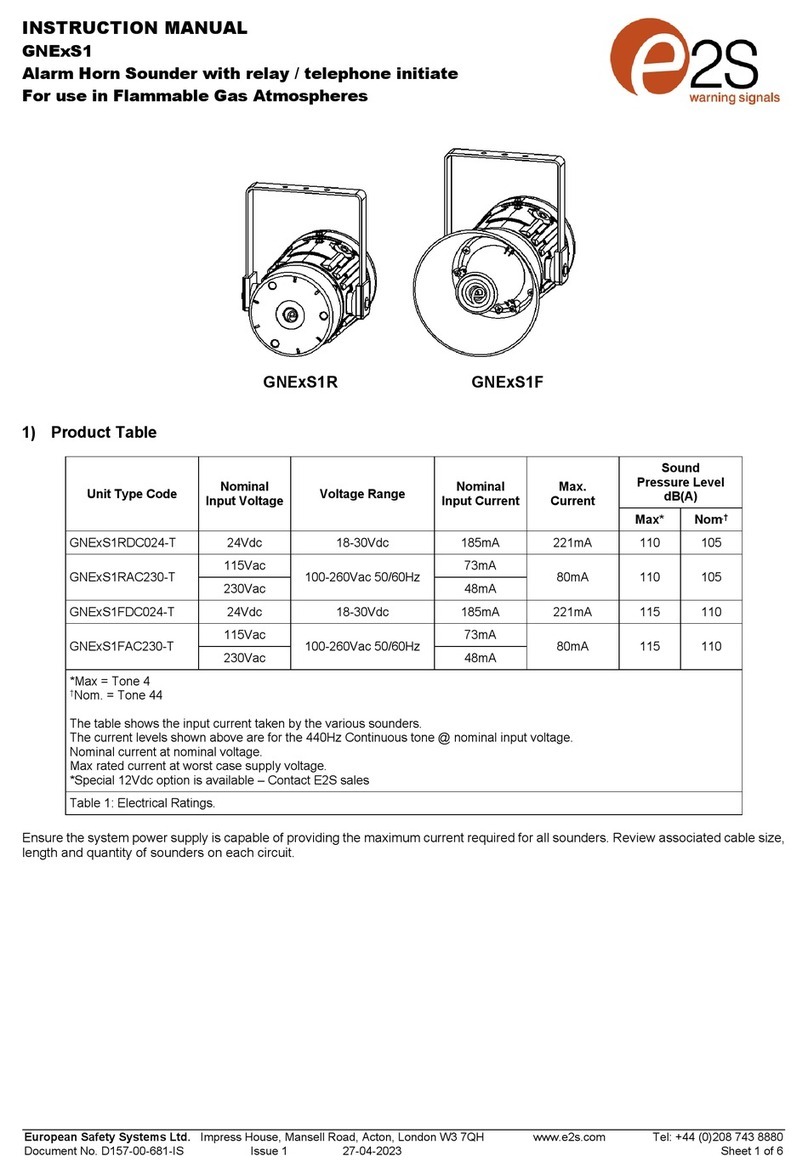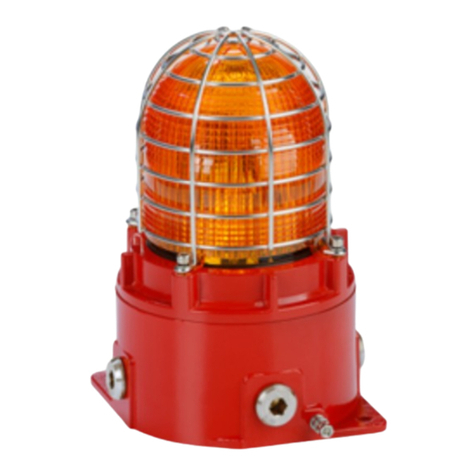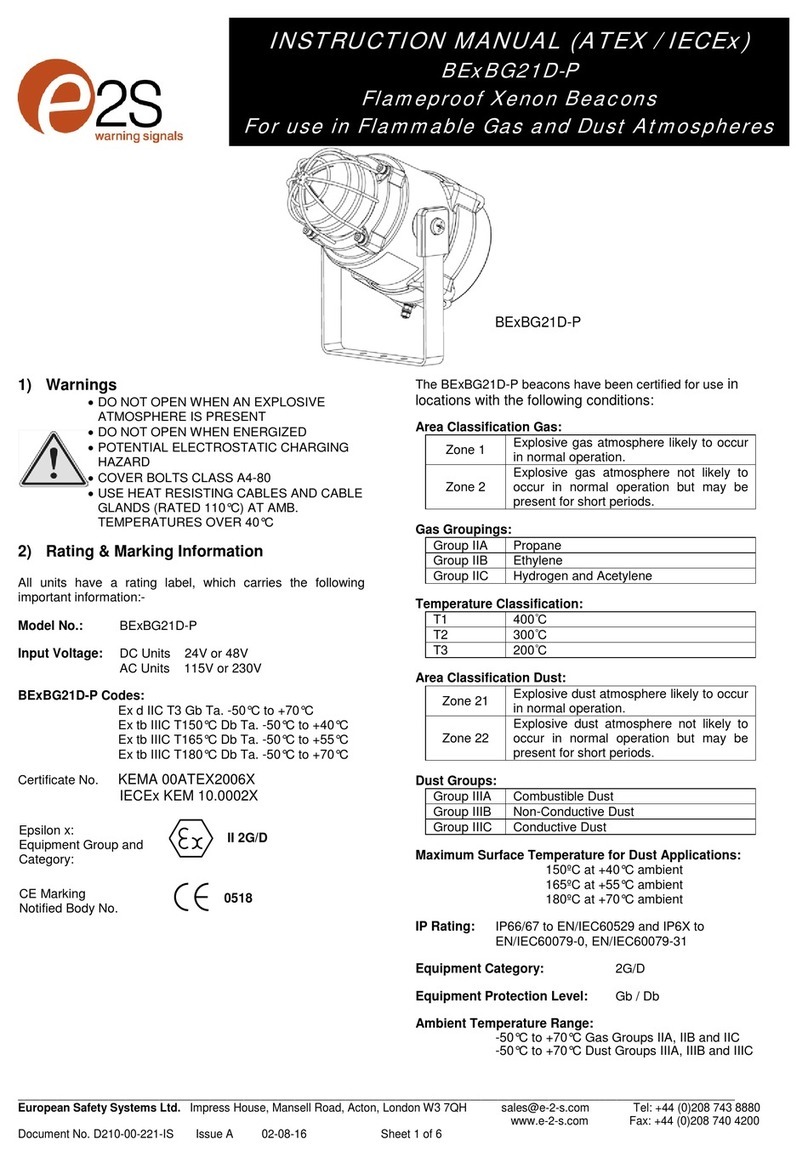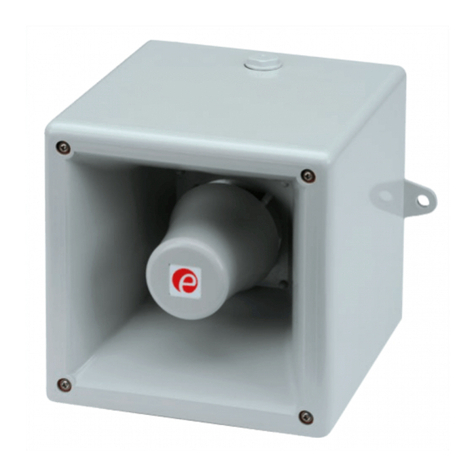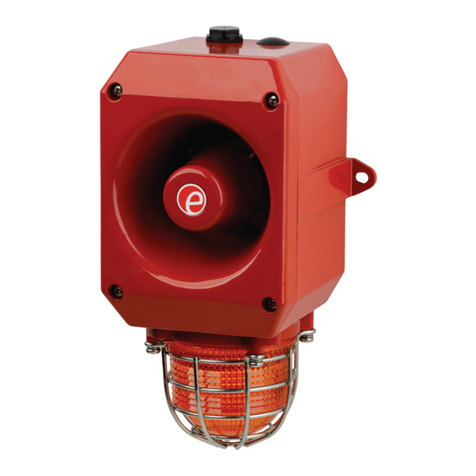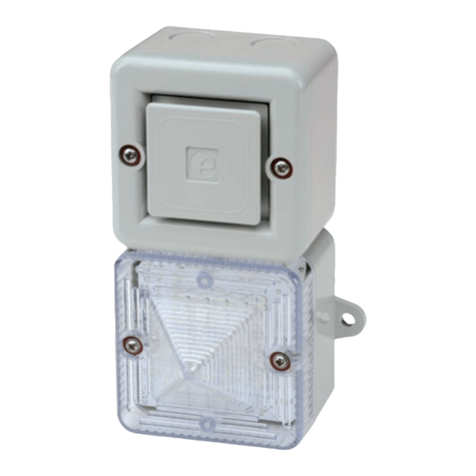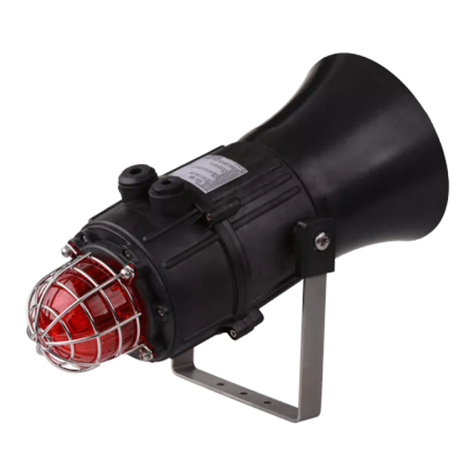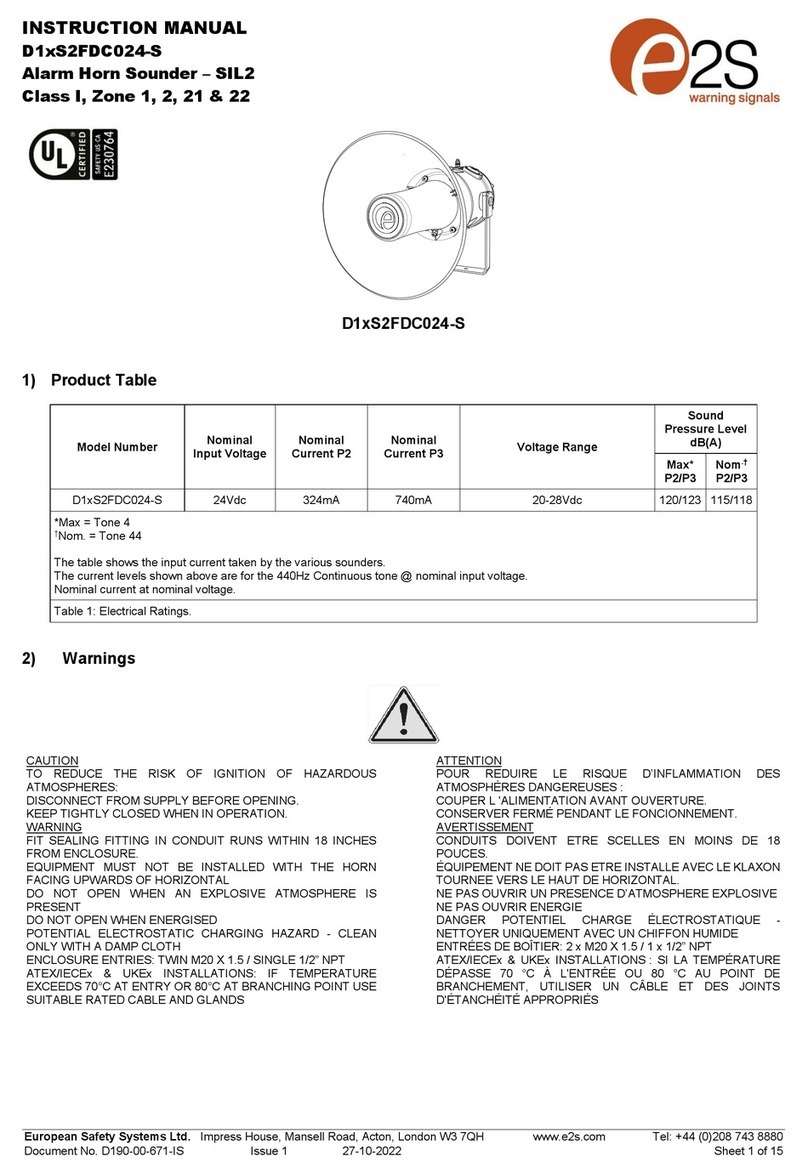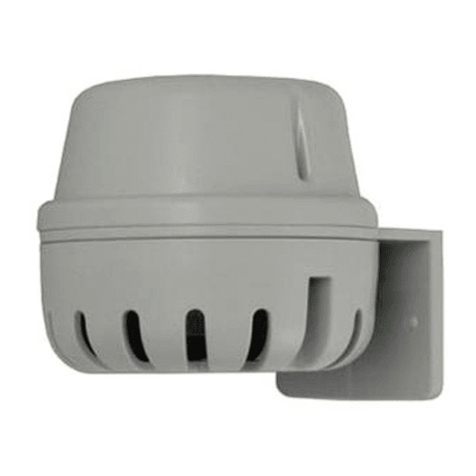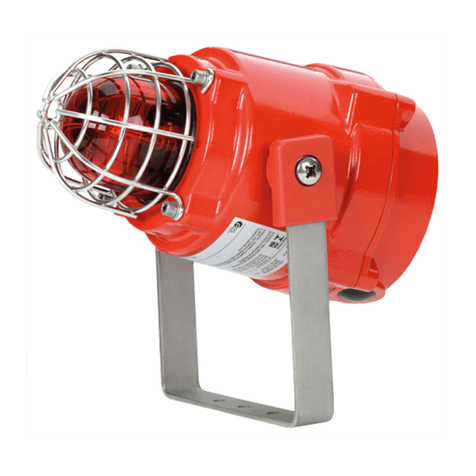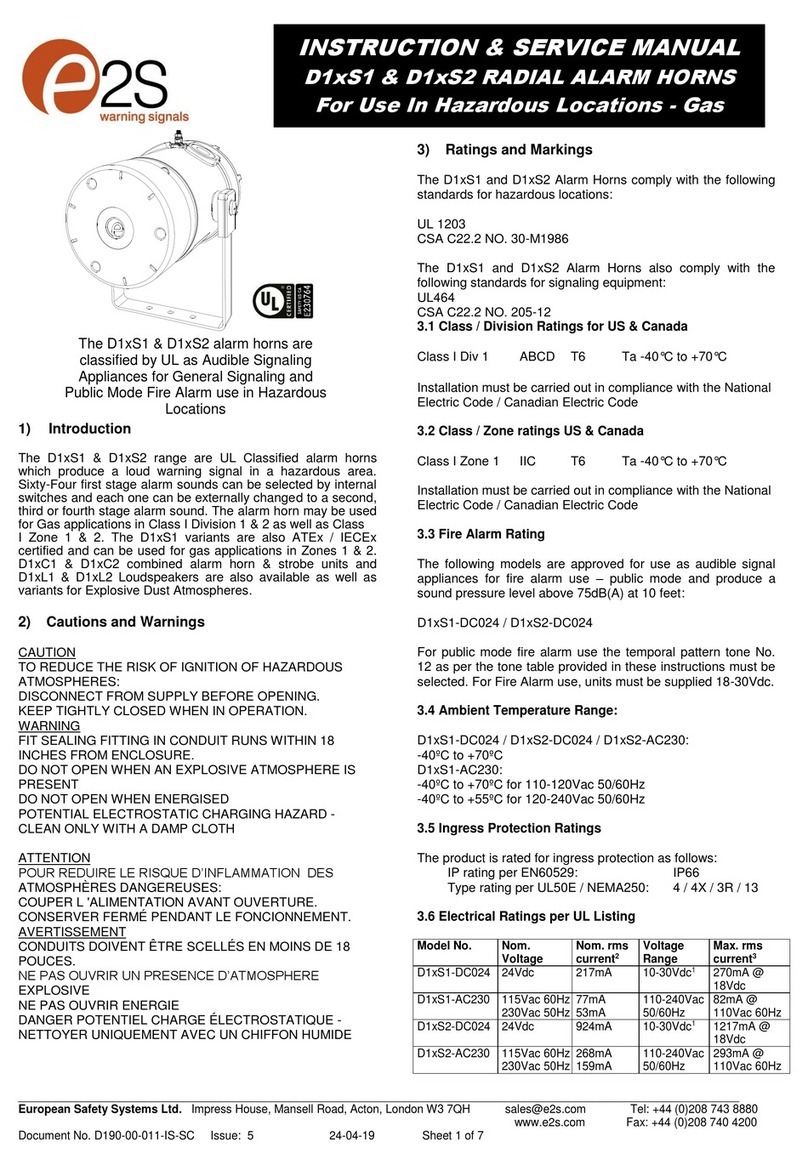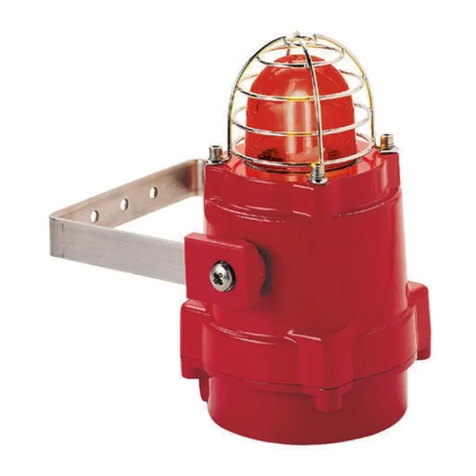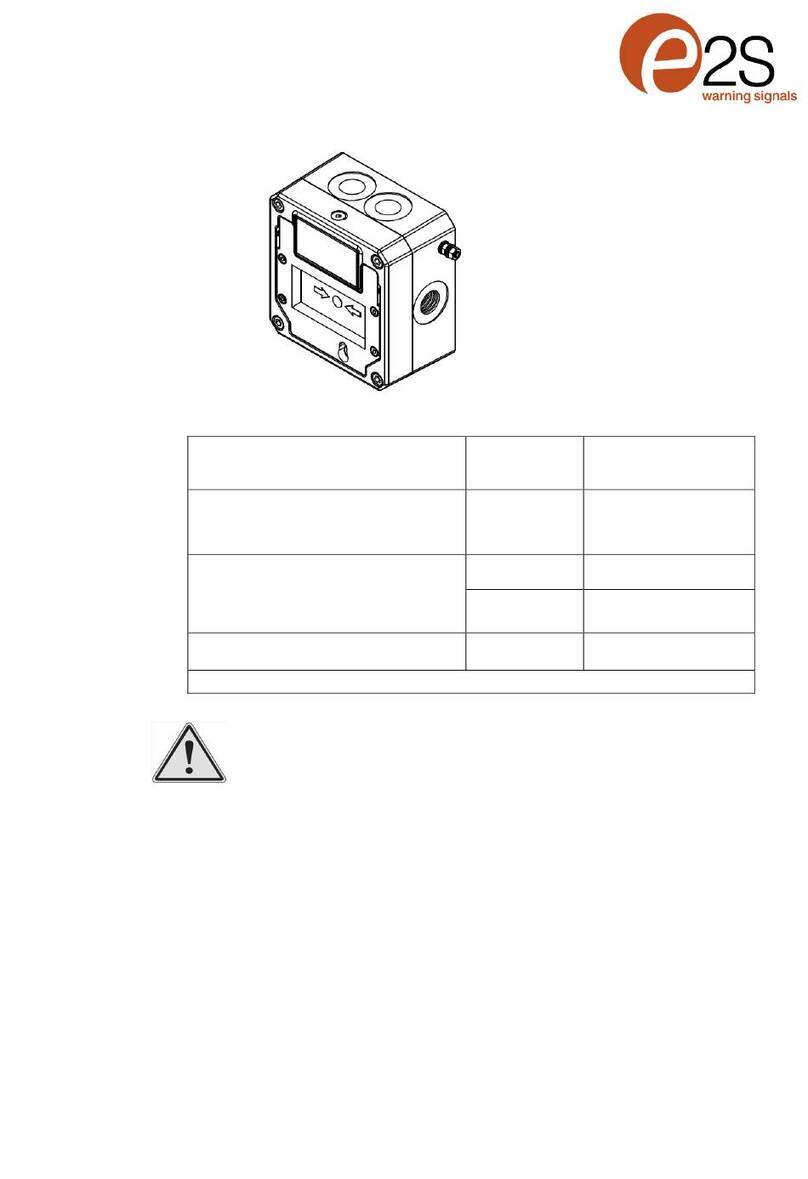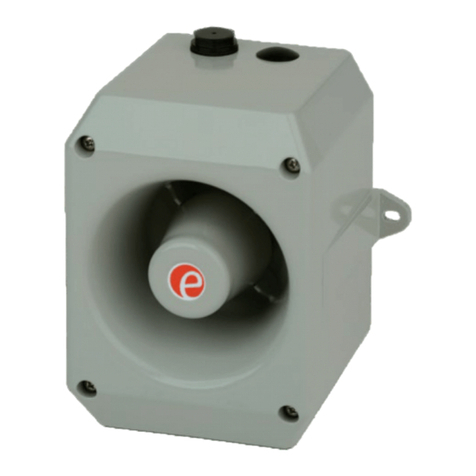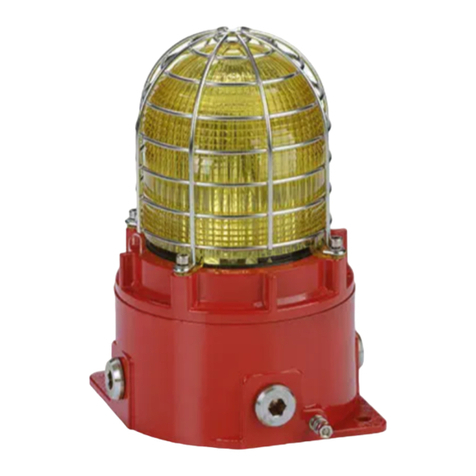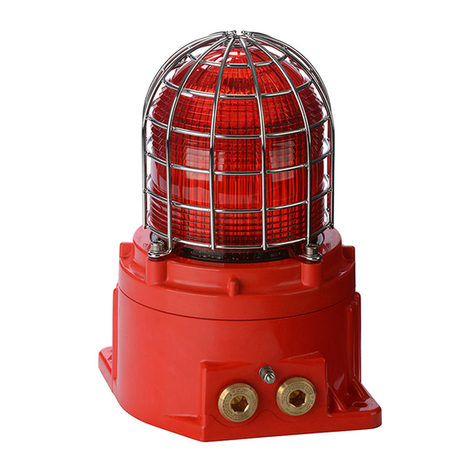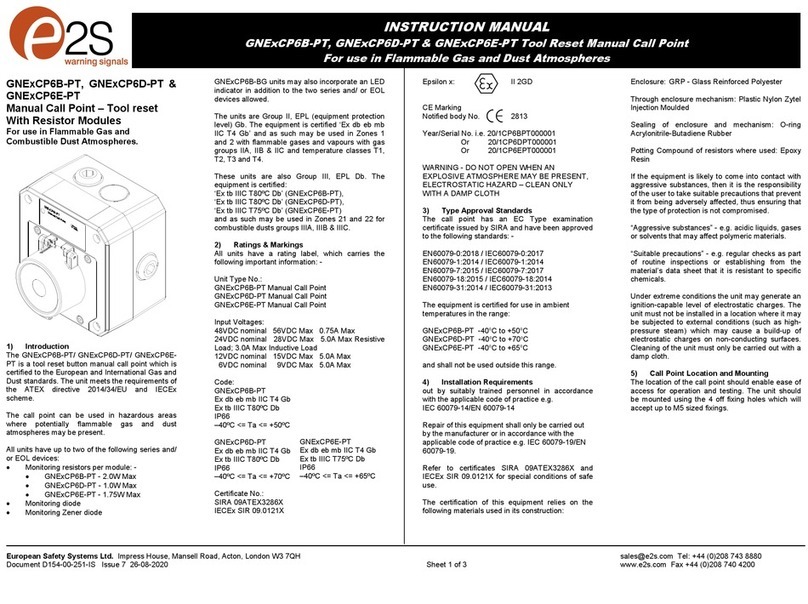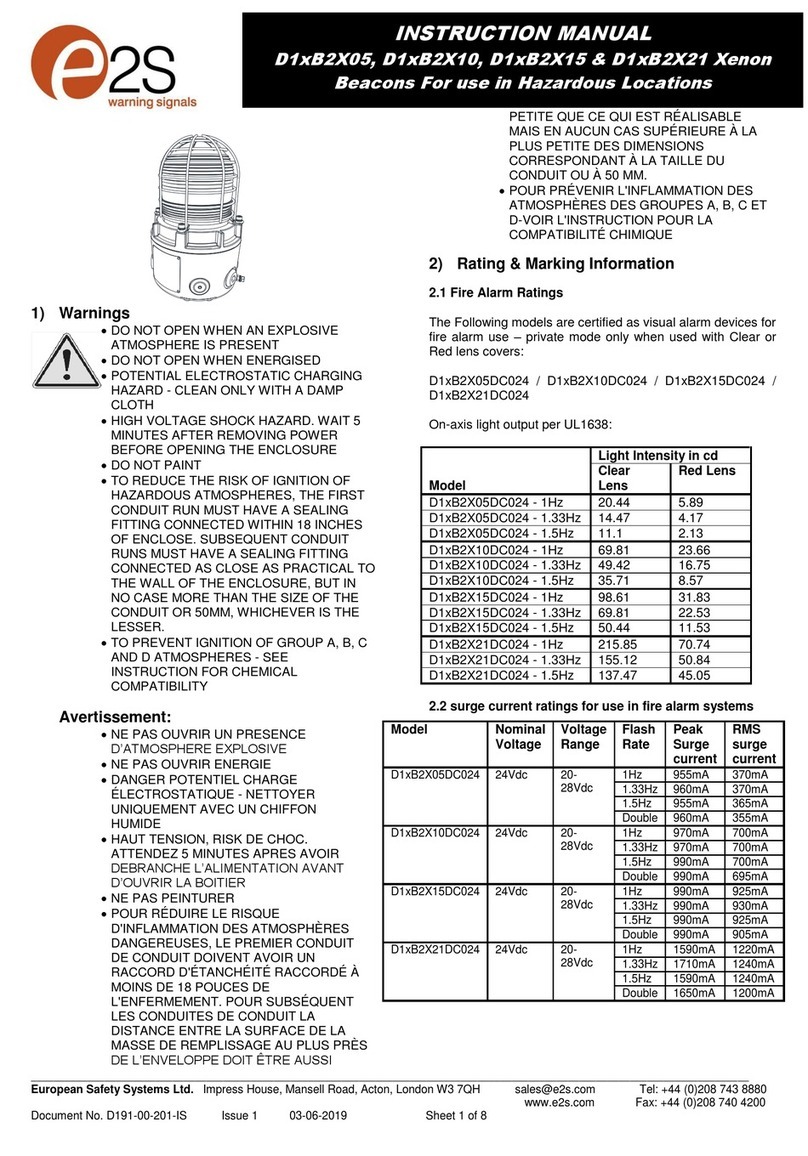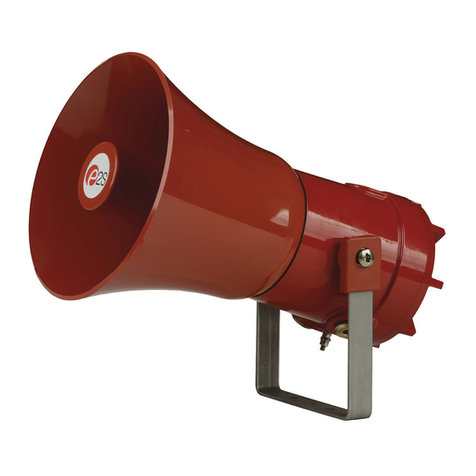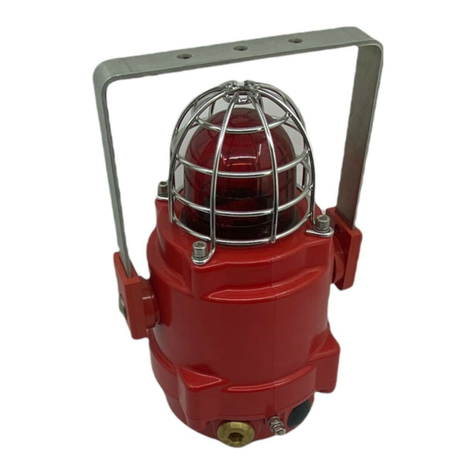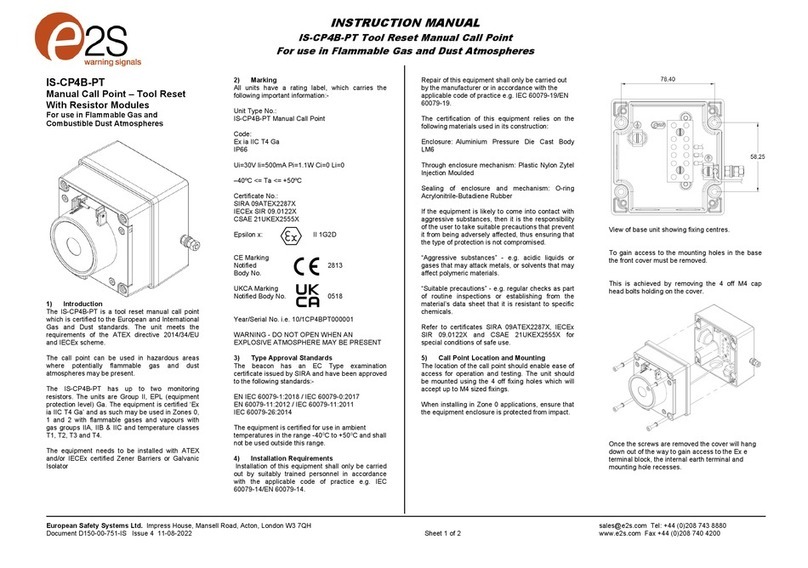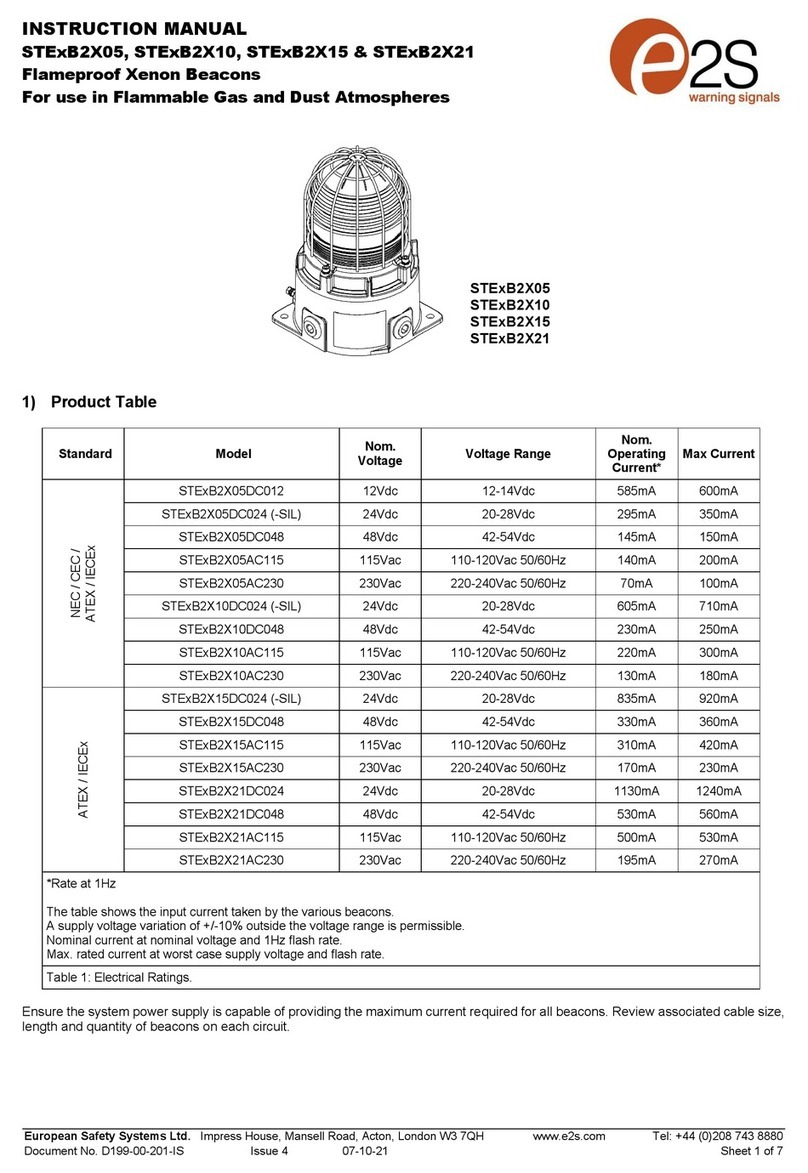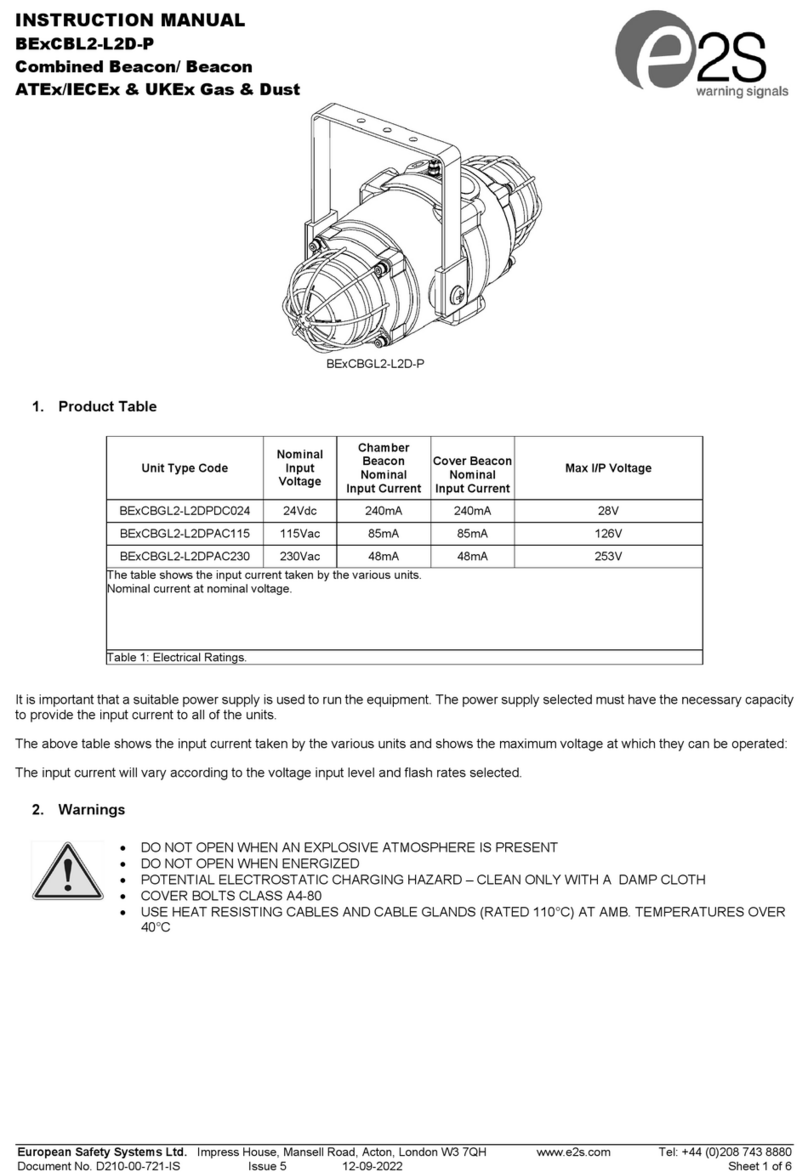
__________________________________________________________________________________________________________________
European
Safety
Systems
Ltd.
Impress House, Mansell Road, Acton, London W3 7QH [email protected] Tel: +44 (0)208 743 8880 www.e2s.com Fax: +44 (0)208 740 4200
Document No. D211-00-601-IS-SC Issue: F 02-03-2020 Sheet 2 of 9
The D2xC2X10DC024 Combined unit is rated as follows:
Class I Zone 2 AEx nA IIC T2 Gc Ta -40°C to +50°C
Zone 22 AEx tc IIIC 85°C Dc Ta -40°C to +50°C
The D2xC2X05DC048 & D2xC2X05AC Combined units are
rated as follows:
Class I Zone 2 AEx nA IIC T3 Gc Ta -40°C to +50°C
Zone 22 AEx tc IIIC 95°C Dc Ta -40°C to +50°C
The D2xC2X10DC048 & D2xC2X10AC Combined units are
rated as follows:
Class I Zone 2 AEx nA IIC T2 Gc Ta -40°C to +50°C
Zone 22 AEx tc IIIC 95°C Dc Ta -40°C to +50°C
Installation must be carried out in compliance with the
National Electric Code.
2.5 CEC Class / Zone ratings Canada
The D2xS1 alarm horn complies with the following standards:
CAN/CSA C22.2 No. 60079-0:2015
CAN/CSA C22.2 No. 60079-15:2016
CAN/CSA C22.2 No. 60079-31:2015
The D2xC2X05DC024 Combined unit is rated as follows:
Ex nA IIC T3 Gc X Ta -40°C to +50°C
Ex tc IIIC 75°C Dc Ta -40°C to +50°C
The D2xC2X10DC024 Combined unit is rated as follows:
Ex nA IIC T2 Gc X Ta -40°C to +50°C
Ex tc IIIC 85°C Dc Ta -40°C to +50°C
The D2xC2X05DC048 & D2xC2X05AC Combined units are
rated as follows:
Ex nA IIC T3 Gc X Ta -40°C to +50°C
Ex tc IIIC 95°C Dc X Ta -40°C to +50°C
The D2xC2X10DC048 & D2xC2X10AC Combined units are
rated as follows:
Ex nA IIC T2 Gc X Ta -40°C to +50°C
Ex tc IIIC 95°C Dc X Ta -40°C to +50°C
Installation must be carried out in compliance with the
Canadian Electric Code
2.6 ATEX / IECEx certification
The D2xC2X05 and D2xC2X10 Combined alarm horn and
xenon beacon comply with the following standards:
EN60079-0:2012+A11:2013 / IEC60079-0: ed. 6.0 (2011-06)
EN60079-15:2010 / IEC60079-15: ed. 4.0 (2010-01)
EN60079-31:2014 / IEC60079-31:2013 ed. 2.0 (2013-11)
Certificate No. DEMKO 14 ATEX 4786493904X
IECEx ULD 14.0004X
The D2xC2X05DC024 Combined unit is rated as follows:
The D2xC2X10DC024 Combined unit is rated as follows:
The D2xC2X05DC048 & D2xC2X05AC Combined units are
rated as follows:
The D2xC2X10DC048 & D2xC2X10AC Combined units are
rated as follows:
CE Marking
Zones, Gas / Dust Groups and Temperature Classification
When connected to an approved system the D2X alarm horn
may be installed in:
Zone 2 explosive gas air mixture not likely to occur in
normal operation, and if it does, it will only exist for a
short time.
Zone 22 explosive dust air mixture not likely to occur in
normal operation, and if it does, it will only exist for a
short time.
May be used with gases in groups:
Group IIA propane
Group IIB ethylene
Group IIC hydrogen / acetylene
Having a temperature classification
(for Gas applications) of:
T1 450ºC
T2 300ºC
T3 200ºC (D2xC2X05 only)
May be used with Dust types:
Group IIIA combustible flyings
Group IIIB non-conductive dust
Group IIIC conductive dust
Maximum Surface Temperature for Dust Applications:
D2xC2X05DC024 = 75°C
D2xC2X10DC024 = 85°C
All 48VDC, 115VAC & 230VAC units = 95°C
Installation must be carried out in compliance with the latest
issue of the following standards:
EN60079-14 / IEC60079-14: Explosive atmospheres - Electrical
installations design, selection and erection
EN60079-10-1 / IEC60079-10-1: Explosive atmospheres -
Classification of areas. Explosive gas atmospheres
EN60079-10-2 / IEC60079-10-2: Explosive atmospheres –
Classification of areas. Explosive dust atmospheres
2.7 Ingress Protection Ratings
The product is rated for ingress Protection as follows:
IP rating: IP66
Type rating per UL50E / NEMA250: 4 / 4X / 3R / 13
To maintain the ingress protection rating, the two off cable
entries must be fitted with suitably rated, certified cable entry
and/or blanking devices during installation.
2813
II 3G Ex nA IIC T3 Gc Ta -40°C to +50°C
II 3D Ex tc IIIC 95°C Dc Ta -40°C to +50°C
II 3G Ex nA IIC T2 Gc Ta -40°C to +50°C
II 3D Ex tc IIIC 95°C Dc Ta -40°C to +50°C
II 3G Ex nA IIC T3 Gc Ta -40°C to +50°C
II 3D Ex tc IIIC 75°C Dc Ta -40°C to +50°C
II 3G Ex nA IIC T2 Gc Ta -40°C to +50°C
II 3D Ex tc IIIC 85°C Dc Ta -40°C to +50°C
